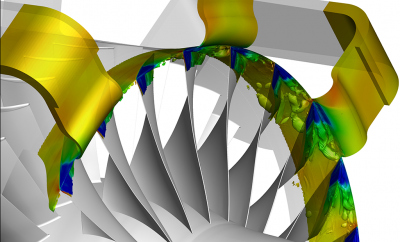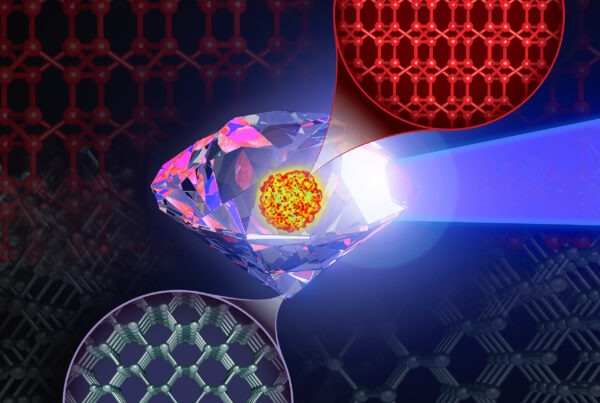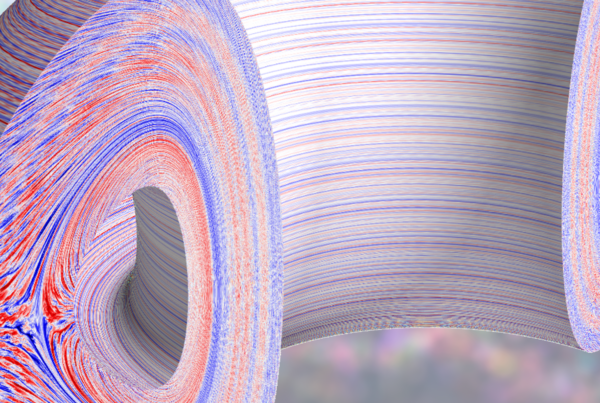Allan Grosvenor of Ramgen Power Systems and co-authors on a Proceedings of ASME Turbo Expo 2014 paper simulated a NASA-designed transonic fan stage on Titan. The “Stage 67” design includes a novel tip injection flow control device that has the potential to improve turbomachine performance. This visualization from the high-resolution simulation shows the tip clearance vortex between rotor tip and casing in a state of deterioration as the compressor approaches stall. Image: Grosvenor, et al. Proceedings of ASME Turbo Expo (2014). Video Credit: Ramgen Power Systems.
Fluid dynamics test cases validate CFD models used in design optimization
Engineering turbomachines that routinely punch past the sound barrier will require more brain than brawn. In fact, it will take more than a thousand-trillion calculations per second on the nation’s most powerful supercomputer to simulate the precise design spaces and complex fluid dynamics that affect machine performance.
Ramgen Power Systems—a small research and development company in Bellevue, Washington that specializes in energy-related applications of supersonic aircraft technology—is using the Titan supercomputer managed by the Oak Ridge Leadership Computing Facility (OLCF) at Oak Ridge National Laboratory to optimize novel designs based on aerospace shock wave compression technology for gas compression systems, such as carbon dioxide compressors.
Efficient compression of CO2 to 100 atmospheres (or 100 times the pressure of the air we breathe) could decrease the high cost of carbon capture and sequestration (CCS). CCS requires pressurizing large-scale fossil fuel emissions from power plants for storage in natural or manmade reservoirs. The expense of current CO2 compression is a factor in preventing the widespread application of CCS. Ramgen estimates its CO2 compressor design could reduce capital costs by 50 percent and operating costs by 25 percent.
The company predicts it will be able to offer this cost-effective technology in part because of an ambitious computational approach using intelligently driven optimization, which calculates the best available option within given parameters for predicting an optimally performing design. Ramgen’s intelligently driven simulations are carried out on the 27-petaflop Titan, which Ramgen accesses through a Department of Energy Advanced Scientific Computing Research Leadership Computing Challenge award, first on Titan’s predecessor Jaguar then on Titan with additional OLCF Director’s Discretion time.
“The technology Ramgen is trying to develop is unlike traditional turbomachines,” said Allan Grosvenor, senior engineering and computational fluid dynamics (CFD) lead who was instrumental in this work. “Developing something new and different necessitates a unique understanding of complicated aerodynamics taking place in these machines.”
Compressing time-to-solution requires Titan-ic strength
Rather than spend millions of dollars and years testing a suite of prototypes, Ramgen enlists Titan to simulate ensembles of thousands of designs using CFD models based on approximately 50 variables and five to 10 operating conditions.
“We take the first thousand design perturbations equally distributed in the design space, then fit a surrogate model to the data,” Grosvenor said.
A surrogate model approximates the performance of every perturbation of the design. Then an evolutionary algorithm searches the space to predict higher performing designs based on the results of the surrogate model. Once design options are narrowed, the team can repeat optimization to refine its search for the optimally performing design.
“Three years ago, we were not using optimization as extensively in our design as we do today,” said Silvano Saretto, Ramgen Aero team lead. “We’ve started to intensively use the Titan supercomputer to take an initial aerodynamic design and greatly improve its performance. Ultimately what we do at the end is physically test the design that is produced via the computational optimization cycle.”
However, before Ramgen can commit to designs identified through intelligently-driven optimization, the CFD team has to make sure the models driving optimization are accurately capturing the aerodynamic phenomena on which its designs depend. The competitive edge lies in understanding the complex substructures in gas flow that occur at supersonic speeds—a tough study with instrumentation and conventional computing systems.
Fortunately, Titan has its own brand of supersonic speed—a highly parallel, CPU–GPU hybrid architecture that often runs simulations of unrivaled detail.

The tip clearance vortex between rotor tip and casing in a state of deterioration as “Stage 67” transonic compressor approaches stall. Image Credit: Ramgen Power Systems
Running Stage 67 on Titan
To validate the accuracy of their CFD models against real-world data, Grosvenor and the team conducted singular, rather than ensemble, prototype simulations based on experimental cases carried out by Ramgen or others in the turbomachine community. Comparing CFD results to observational or experimental data gauge how well the model under development is replicating real systems.
“There are a lot of CFD methodologies out there that don’t fit our needs, especially since we’re running on such a large machine with extremely high resolution,” Grosvenor said.
The team’s latest CFD test case simulates a transonic fan stage using data from a prototype called “Stage 67” designed and built by NASA Glenn Research Center in 2004. The fan stage includes rotor blades and stationary stator vanes, which work together to transfer energy to the fluid entering the fan.
What makes the case particularly interesting to Ramgen and a unique computational investigation is the addition of a tip injection flow control for the purpose of delaying stall. Tip injection recirculates gas flow from downstream of the stage through injectors (there are eight injectors in the test case design) mounted on the casing at the front of the rotor blades.
“Approaching stall, a transonic compressor has very specific kinds of vortex flow features that exist at the tip of the blade adjacent to the casing. These are particularly affected by the shock waves present at such high operating speeds,” Grosvenor said.
Because shock waves abruptly change fluid flow through the compressor, they introduce instability in a system that is already harnessing a great deal of potential energy in the form of compressed fluid. Stall can cause a decrease in performance, but it can also reverse gas flow, impacting speed or operation.
Ramgen wanted to investigate exactly how tip injection influences stall. The results of the study have been published in conjunction with the Proceedings of the ASME Turbo Expo 2014 in the paper “High Resolution RANS NLH Study of Stage 67 Tip Injection Physics.”
For the CFD community at-large, not only does this study provide information on the influence of tip injection, the simulated Stage 67 builds on an earlier, well known, and widely replicated CFD test case from NASA known as “Rotor 67.”
In the 1980s, NASA Glenn published results from its evaluation of Rotor 67—the rotor design used in the later 2004 Stage 67 prototype. Rotor 67 is a transonic fan rotor that was designed and tested to produce experimental data relevant to the front stages of aviation turbofan gas turbine engines.
“Rotor 67 is probably one of the most, if not themost, famous turbomachinery test cases for CFD,” Grosvenor said. “When NASA Glenn conducted experiments with that configuration, they did such an excellent job of producing detailed information about the geometry and experimental data that it has prompted people from all over the world to compare their CFD runs with that case study.”
And now Stage 67 has received the CFD treatment on Titan, adding to the understanding gained through the 2004 experiment.
The experimental data suggested tip injection was successful at delaying stall, but the Ramgen team wanted to study the aerodynamic phenomena dictating performance of the fan stage for a fundamental understanding of the interaction between the compressed gas in the stage and the jets of injected gas.
Experiment can only reveal so much, in part because stall initiates at a space in the compressor that is especially difficult to physically monitor with instrumentation.
“There are not a lot of details available on the interaction zone between injected jets and rotor tip flow that you can get from experiments, so based on experimental data, we didn’t know exactly what was physically happening there,” Grosvenor said.
Titan gets down to details
Good thing Titan is adept at simulating inconvenient spaces, such as the miniscule spaces between atoms or the vast spaces found in the universe—or the tight spaces in a transonic compressor.
Using the FINE/Turbo code developed by Numeca, the team modeled 1.5 billion grid cells that comprised Stage 67 with blades rotating at 16,043 rpm. The time-varying interaction of rotor flow with the injected jets and downstream stators was computed.
For comparison, simulations were generated at three levels of grid resolution with a factor-of-eight increase in spatial resolution at each level. The two highest levels (18.6 million and 148 million grid cells per rotor passage) resolved secondary vortex (spinning fluid) structures that were observed computationally for the first time and never detected experimentally.
“The origin of stall in this sort of transonic compressor is the tip region of the rotor, and our paper gives insight into how the injected jets in that region manipulate the viscous shear flow, and particularly the dominating vortex structures, to delay stall,” Grosvenor said. Researchers found the coarsest resolution (on par with CFD simulations commonly used in industry) to inadequately predict the influence of the injected jets because it could not resolve secondary substructures.
Ultimately for Ramgen, investigating the performance of injection flow control on Stage 67 provides insight for future optimization of its CO2 compressor and other designs.
And if Titan’s keeping track, it can check off another inconvenient space explored. —Katie Elyce Jones
Related Publication: The authors of the paper reporting Stage 67 results on Titan include Grosvenor, Gregory S. Rixon, and Logan M. Sailer of Ramgen; Michael A. Matheson of the OLCF; David P. Gutzwiller and Alain Demeulenaere of Numeca USA; Mathieu Gontier of Numeca International; and Anthony J. Strazisar of AJS Aero Incorporated.





